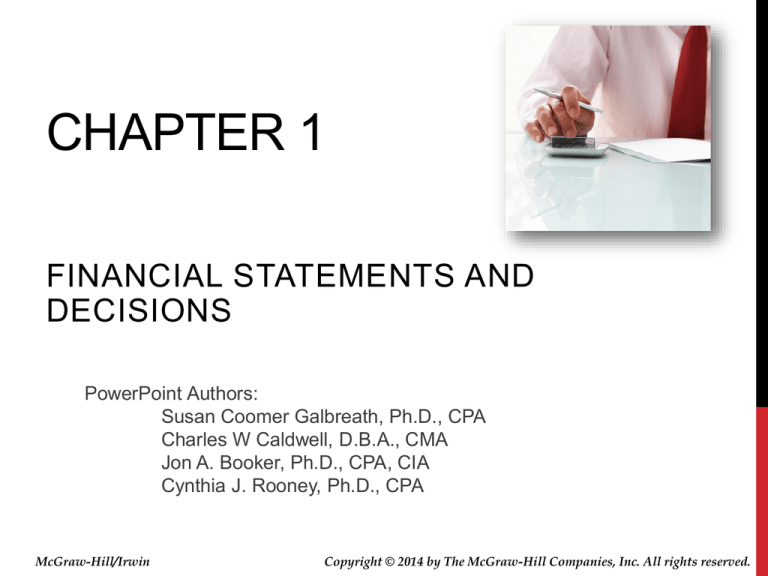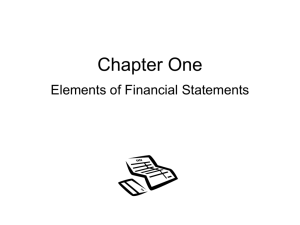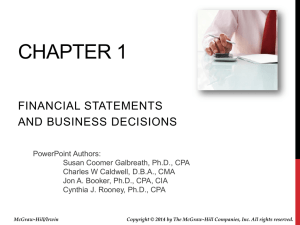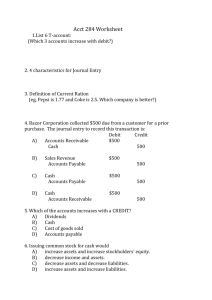
CHAPTER 1
FINANCIAL STATEMENTS AND
DECISIONS
PowerPoint Authors:
Susan Coomer Galbreath, Ph.D., CPA
Charles W Caldwell, D.B.A., CMA
Jon A. Booker, Ph.D., CPA, CIA
Cynthia J. Rooney, Ph.D., CPA
McGraw-Hill/Irwin
Copyright © 2014 by The McGraw-Hill Companies, Inc. All rights reserved.
THE ACCOUNTING SYSTEM
1-2
THE FOUR BASIC FINANCIAL
STATEMENTS
BALANCE SHEET – reports the amount of assets, liabilities, and
stockholders’ equity of an accounting entity at a point in time.
INCOME STATEMENT – reports the revenues less the expenses of the
accounting period.
STATEMENT OF STOCKHOLDERS’ EQUITY – reports the changes in
each of the company’s stockholders’ equity accounts, including the
change in the retained earnings balance caused by net income and
dividends during the reporting period.
STATEMENT OF CASH FLOWS – reports inflows and outflows of cash
during the accounting period in the categories of operating, investing,
and financing.
1-3
BALANCE SHEET
Elements of the Balance Sheet
Assets
Cash
Short-Term Investment
Accounts Receivable
Notes Receivable
Inventory (to be sold)
Supplies
Prepaid Expenses
Long-Term Investments
Equipment
Buildings
Land
Intangibles
Liabilities
Accounts Payable
Accrued Expenses
Notes Payable
Taxes Payable
Unearned Revenue
Bonds Payable
Stockholders’ Equity
Common Stock
Retained Earnings
1-4
THE ACCOUNTING EQUATION
A = L + SE
Assets
Economic
Resources
Liabilities
Stockholders’
Equity
Sources of Financing for Economic
Resources
Liabilities: From Creditors
Stockholders’ Equity: From Stockholders
1-5
BALANCE SHEET
1-6
INCOME STATEMENT
Elements of the Income Statement
Revenues
Sales Revenue
Fee Revenue
Interest Revenue
Rent Revenue
Expenses
Cost of Goods Sold
Wages Expense
Rent Expense
Interest Expense
Depreciation Expense
Advertising Expense
Insurance Expense
Repair Expense
Income Tax Expense
1-7
INCOME STATEMENT
1-8
STATEMENT OF
STOCKHOLDERS’ EQUITY
Elements of the Statement
of Stockholders’ Equity
Common Stock
Retained Earnings
Beginning Retained Earnings
+Net Income
-Dividends
Ending Retained Earnings
1-9
STATEMENT OF
STOCKHOLDERS’ EQUITY
1-10
STATEMENT OF CASH FLOWS
Elements of the Statement
of Cash Flows
Cash Flows from Operating Activities
Cash Flows from Investing Activities
Cash Flows from Financing Activities
/
Note that each of the three cash flow
sources can be positive (net cash inflow)
or negative (net cash outflow).
1-11
STATEMENT OF CASH FLOWS
1-12
GENERALLY ACCEPTED
ACCOUNTING PRINCIPLES
The SEC has worked closely with the
accounting profession to
work out the detailed rules that have
become known as GAAP.
Currently, the Financial Accounting Standards Board
(FASB) is recognized as the body to formulate GAAP.
1-13
ENSURING THE ACCURACY OF
FINANCIAL STATEMENTS
To ensure the accuracy of the company’s
financial information, management:
Maintains a system of controls.
Hires external independent auditors.
Forms a committee of the board of directors
to review these other two safeguards.
1-14
END OF CHAPTER 1
1-15










